
Liquid crystal display technology has been continuously advancing, from the most commonly heard LCD, LED, OLED, to the currently hottest display technologies in the industry: Micro LED, Mini LED, and Micro OLED. Have you ever thought about understanding them but found it confusing? Here, we will briefly introduce the characteristics of these next-generation display technologies from a scientific perspective, as well as their differences from older technologies.
1. What are the Differences Between LCD, LED, and OLED?
LCD stands for “Liquid Crystal Display”. Currently, most of the market uses “Thin Film Transistor Liquid Crystal Display” (TFT-LCD) technology, which consists of two glass substrates sandwiching a layer of liquid crystal. The upper glass substrate has a color filter, while the lower glass substrate is embedded with transistors. When current flows through the transistors, the electric field changes, causing the liquid crystal molecules’ original rotational arrangement to twist, thereby altering the rotation amplitude of the light passing through and projecting different colors onto the color filter.
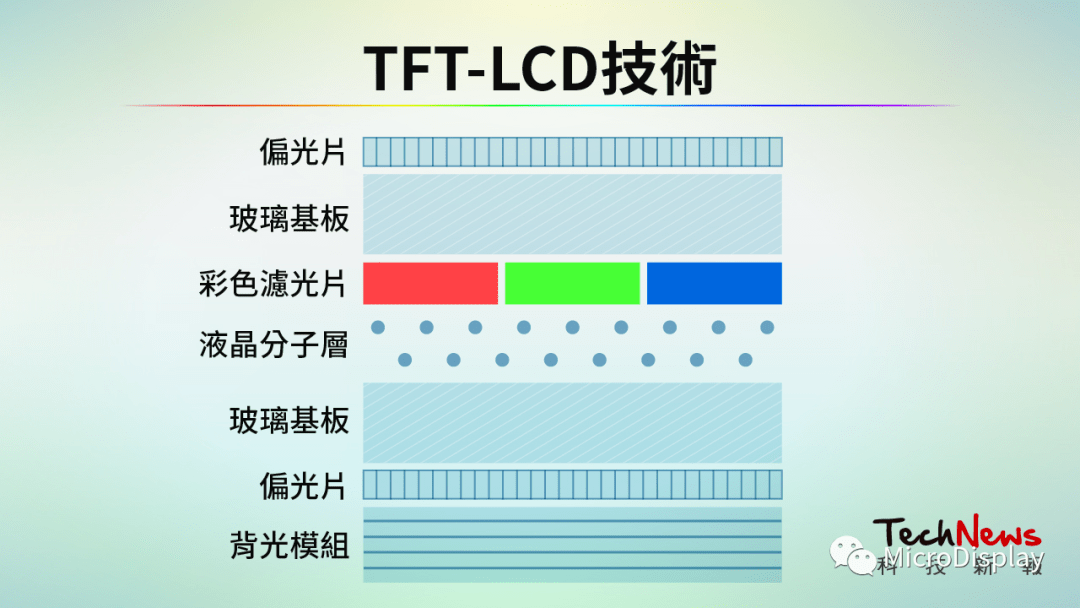 LCD panels most commonly use TFT-LCD technology (Source: Technology News Report)
LCD panels most commonly use TFT-LCD technology (Source: Technology News Report)
Currently, LCD technology is quite mature and is used in general computer and television screens, with low costs, making it a basic technology for consumer products.
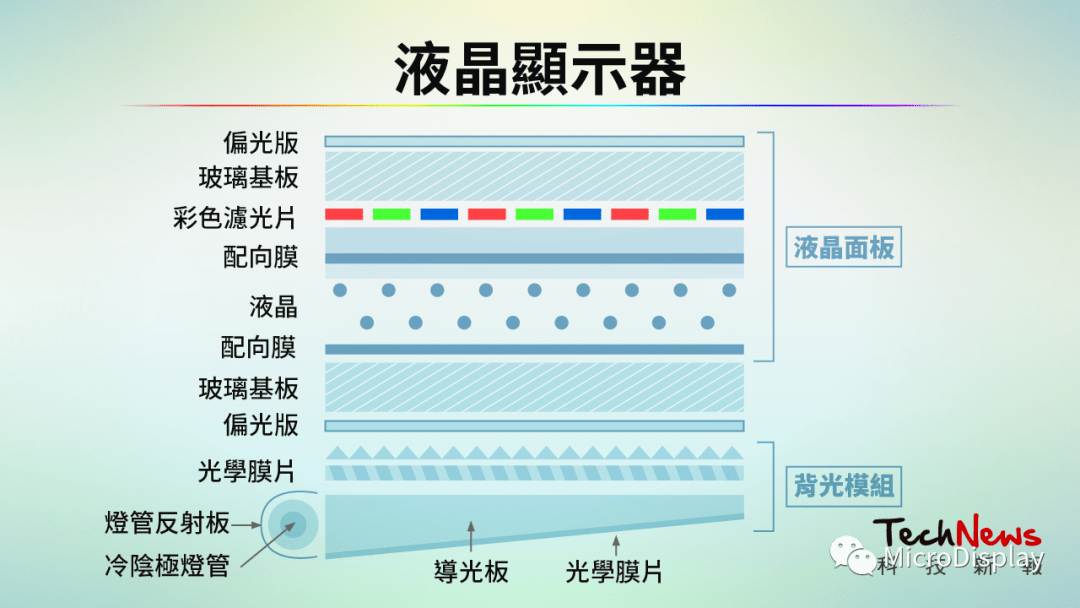 The imaging principle of a typical LCD (Source: Technology News Report)
The imaging principle of a typical LCD (Source: Technology News Report)
After understanding LCD, let’s introduce LED and OLED.
LED stands for “Light Emitting Diode”. It converts electrical energy into light energy. By applying voltage across the two terminals of a semiconductor, when current flows, electrons combine with holes, and the remaining energy is released in the form of visible light. Depending on the materials used, the photon energy will produce different wavelengths of light. Direct-view LEDs are commonly used in outdoor television walls or traffic lights, while LED chips are currently the mainstream products for backlighting in televisions and displays.
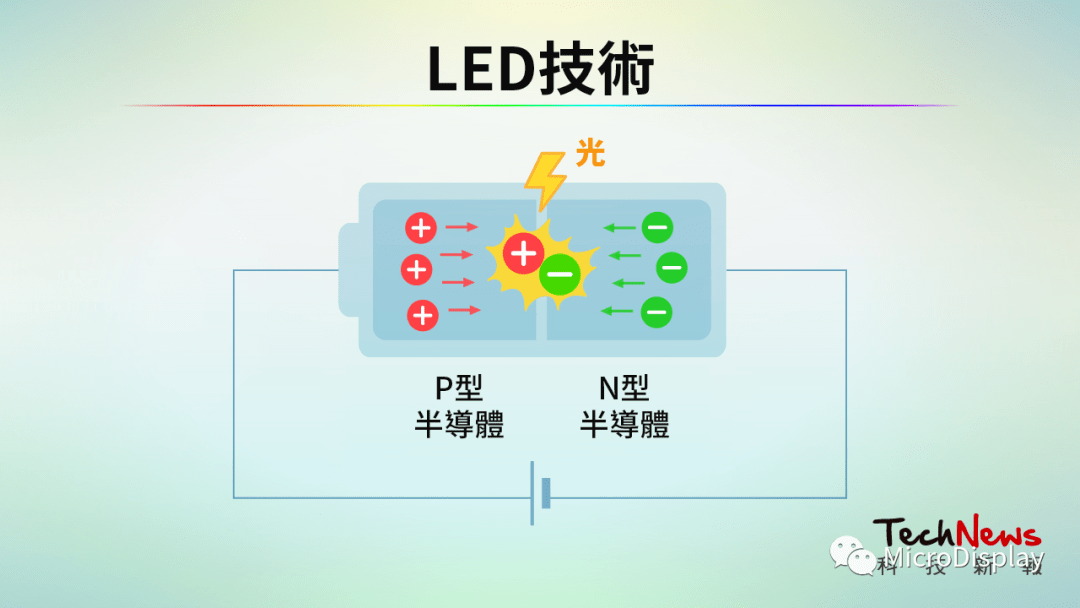 LED technology utilizes electrical energy to convert into light energy. (Source: Technology News Report)
LED technology utilizes electrical energy to convert into light energy. (Source: Technology News Report)
LED and OLED have similar driving concepts, but the materials used are completely different. OLED stands for “Organic Light Emitting Diode”. Its basic structure consists of a layer of organic material emitting light, created on indium tin oxide (ITO) glass, and covered with a layer of low work function metal electrode. Driven by external voltage, the positive holes and negative electrons combine in the light-emitting layer, generating energy and emitting light, producing the primary colors of R, G, and B based on the material characteristics to form basic colors.
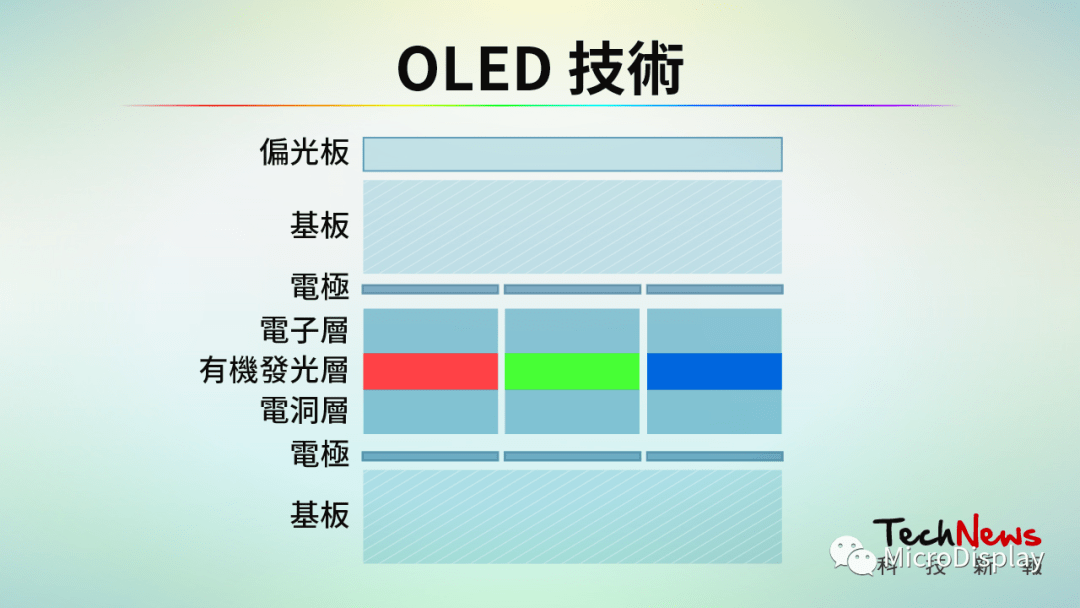 OLED technology (Source: Technology News Report)
OLED technology (Source: Technology News Report)
The biggest difference between OLED and LCD is whether they can emit light by themselves. LCD requires an LED backlight and filter, while OLED can emit light by itself.
Although OLED displays vibrant images, have low power consumption, and can be curved, the organic materials oxidize, resulting in a relatively short lifespan and color burn-in issues. Additionally, due to high costs and technical complexity, they are currently mostly used in small screens, such as mobile phone displays.
2. Confusing Mini LED and Micro LED
After understanding the basic differences between LCD, LED, and OLED, let’s look at the advanced display technologies Mini LED, Micro LED, and Micro OLED.
The most intuitive difference between Mini LED and Micro LED is the size of the LED crystals, but conceptually there are some differences. Mini LED is formally named “Sub-Millimeter Light Emitting Diode”, while Micro LED refers to “Micro Light Emitting Diode”. The crystal sizes of the two are essentially differentiated by 100 μm, approximately 0.1 mm.
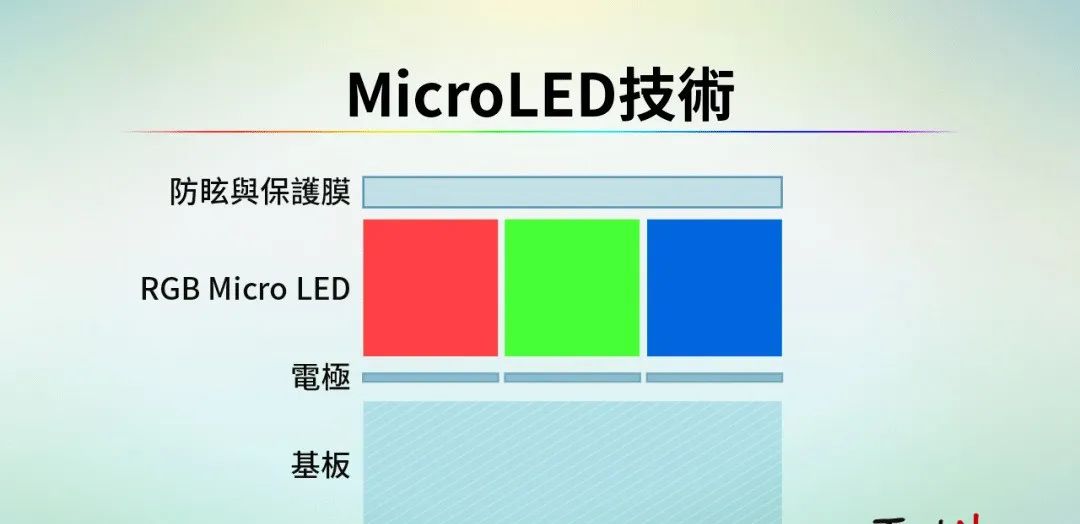 Micro LED technology structure (Source: Technology News Report)
Micro LED technology structure (Source: Technology News Report)
Mini LED is seen as a transitional phase to Micro LED, an improved version based on traditional LED backlighting, used as backlight sources for LCD panels. Micro LED, on the other hand, represents a new generation of display technology that miniaturizes and matrices the LED backlight, aiming to individually drive inorganic self-emitting (self-luminous) components, extending product lifespan, and even outperforming OLED in performance, being regarded as the next-generation display technology by the industry.
Currently, Mini LED technology is mainly used in “multi-zone backlight displays” and “large RGB small pitch displays”. The “multi-zone backlight control” feature in Mini LED technology can achieve partition dimming, enhancing the picture’s high contrast and high resolution, achieving HDR effects, similar to OLED displays. Another technology involves using Mini LED chips to create large displays with pixel pitch below 1.0 mm, improving the resolution of LED displays and creating new mainstream specifications for displays.
As for Micro LED, it will bring new technological breakthroughs. Its applications are not limited to backlight sources, as the crystals of Micro LED are at a level indistinguishable to the naked eye, allowing the R, G, and B colored crystals to be assembled into a single pixel point, transforming it into the concept of “one pixel”, eliminating the need for filters and liquid crystal layers. This technological characteristic differs completely from the light-emitting structure of past LCD displays, promising a new revolution for the LCD industry.
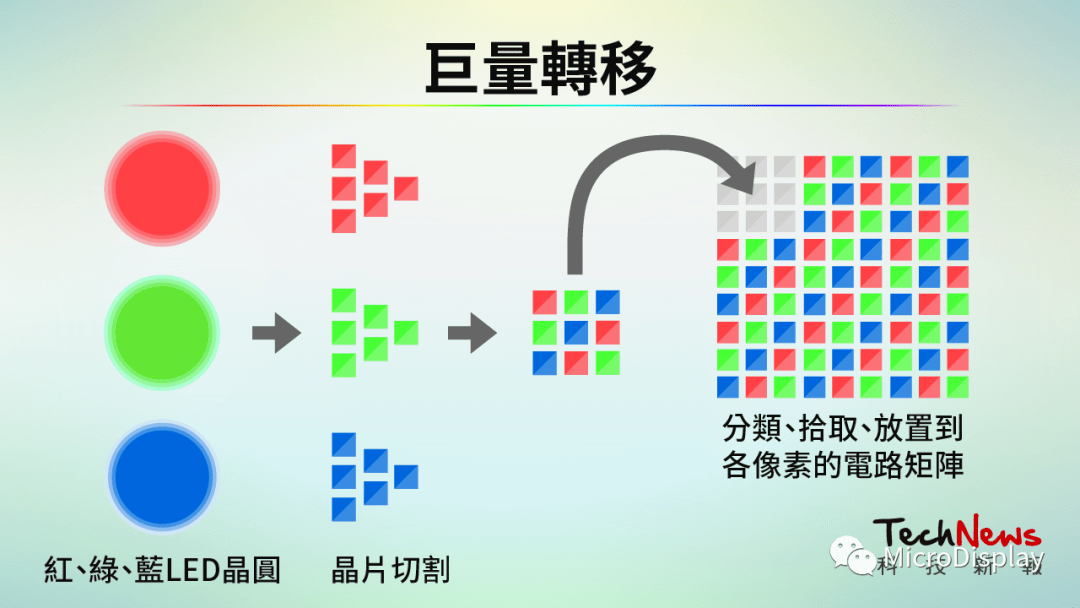 Mass transfer aims to place the crystals accurately onto the circuit matrix, which is very difficult to achieve in practice. (Source: Technology News Report)
Mass transfer aims to place the crystals accurately onto the circuit matrix, which is very difficult to achieve in practice. (Source: Technology News Report)
Besides potentially creating a new situation for the LCD industry, the future applications of Micro LED are broad, including AR/VR devices, automotive screens, and high-resolution wearable products. However, the Micro LED technology faces numerous challenges that need to be addressed, from early-stage epitaxial technology bottlenecks, mass transfer yield issues, packaging and testing problems, to subsequent detection and maintenance, all of which pose significant challenges affecting the mass production of Micro LED.
3. The Next-Generation Technology of OLED: Micro OLED Technology Revolution
Micro OLED, also known as silicon-based OLED (OLED on silicon), combines semiconductor technology with OLED technology to achieve lighter, thinner, and lower power consumption technology, with promising AR/VR applications. But how does it differ from the previously mentioned Micro LED?
However, before this, it is essential to clarify what OLED is and whether Micro OLED is merely a miniature version of OLED.
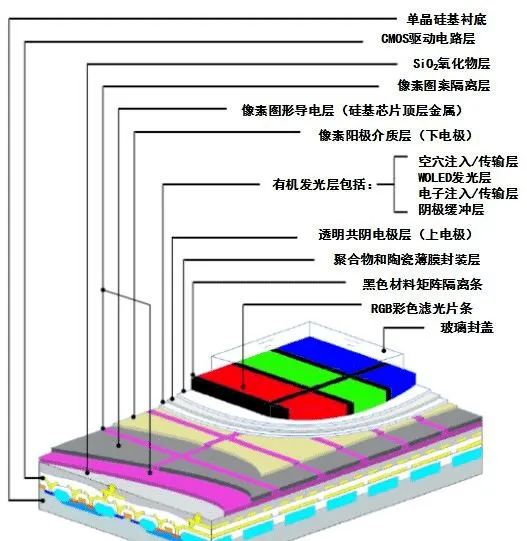 Micro OLED technology
Micro OLED technology
OLED technology has developed for a long time, with most materials being organic materials that do not require a backlight module to emit light through each pixel. Each pixel can emit independent light of a certain color and can be turned on and off individually. Therefore, in addition to having excellent and deep blacks and good contrast, power consumption is also lower than traditional LED and LCD displays.
 Full of OLED pixels (Source: Shutterstock)
Full of OLED pixels (Source: Shutterstock)
Currently, OLED technology has been applied in smartphones and television displays. Although Micro OLED only adds “Micro” in front of its name and originates from OLED, it is a more complex display technology with entirely different market positioning, specifically targeting the AR/VR display field.
Micro OLED primarily uses a layer of light-emitting fluorescent organic material between two layers of electrodes. When current flows, it emits monochromatic light, which is then filtered to generate the required colors. The Micro OLED light source module deposits OLED onto a substrate, while the main silicon-based OLED is deposited onto a silicon substrate (semiconductor wafer). In addition to retaining the self-emitting advantages of OLED, the panel thickness and volume are thinner, smaller, and consume less energy than before, coupled with short response times and high luminous efficiency, making it easier to achieve high ppi (pixels per inch).
This conveniently meets the needs for AR/VR head-mounted displays, display mirrors, etc. Although AR/VR technology has been around for many years, due to the technology itself not being perfected, the actual experience often faces issues of dizziness, low resolution, and large, expensive devices. To solve the dizziness problem, the panel resolution needs to be increased from the current 500 ppi to 2000 ppi.
This is the market for Micro OLED. Although it may not be as bright and has varying degrees of aging issues as OLED, making it challenging to penetrate large-size fields, Micro OLED has obvious advantages in small-size fields. As the application of AR/VR displays expands from gaming and military to medical, education, and retail, the market grows, and the demands for image quality and latency also rise. The new generation of display technology with high resolution, brightness, contrast, and response speed will have development opportunities. Currently, Micro OLED has already been applied in military, industrial, medical, and commercial smart glasses.
4. Micro OLED or Micro LED? Don’t Get Confused!
When mentioning Micro OLED, another advanced display technology with a similar name, Micro LED, is often referenced. However, although both target ultra-high precision, high resolution, high reliability, and fast response times, their processes and applications are entirely different, with only partial overlap in the markets of Micro LED and Micro OLED.
Micro LED is defined as having a size below 75 μm, without a sapphire substrate. In terms of processes, Micro LED adopts different epitaxial technologies, integrating high-density micro-sized LED arrays on chips. Its application fields are vast, ranging from wearable devices, head-mounted displays, AR/VR to phototherapy technologies. Since Micro LED uses inorganic materials, it has higher brightness and is more stable than OLED, which uses organic materials.
Currently, the biggest challenge for Micro LED is how to accurately transfer millions of tiny LEDs onto the backplane (mass transfer), and the subsequent detection and packaging technologies, which are associated with very high investment costs.
In contrast, Micro OLED is not necessarily limited to 75 μm, as the OLED process defines the size of each pixel. Micro OLED primarily uses deposition technology. How to accurately and uniformly deposit organic materials, which are easily affected by oxygen and water, onto substrates will be a key focus of the process, utilizing vacuum deposition machines and precision fine metal masks (FMM).
Many manufacturers are currently developing Micro OLED, mainly because silicon-based Micro OLED technology combines integrated circuit design processes (CMOS) with OLED technology, using single-crystal silicon as the active driving backplane. For example, in March, Nikkei Asia reported that Apple collaborated with its long-term chip supplier TSMC to jointly develop the ultra-advanced display technology Micro OLED.
Additionally, China and South Korea have not overlooked this area. Since 2018, China’s BOE has been developing Micro OLED in partnership with the Kunming BOE Display Technology joint venture in Yunnan. ELEC research indicates that BOE plans to launch commercial Micro OLED displays in the second half of 2021, targeting the AR/VR field, with deposition equipment developed in collaboration with South Korea’s Sunic Systems.
South Korean display and semiconductor equipment manufacturer APS Holdings also revealed in May that they have been approached to handle a Micro OLED display project, with plans to jointly develop 4000 ppi AR glasses before 2024 with other developers.
In 2020, French Micro OLED announced it received €8 million in growth investment from two pan-European high-tech investors, Cipio Partners and Ventech, to promote the development of integrated AR modules.
The market direction for Micro OLED is clear, with significant advantages in small-size fields. Its application range is not as broad as OLED or Micro LED, making it one of the research hotspots in recent years. Many manufacturers have invested in enhancing manufacturing capacity to meet the demands of various fields, which will be a crucial driver for AR/VR and other human-machine devices in the next decade. In fact, several Micro OLED products made their appearance at the 2020 display exhibition, with ppi reaching over 3000.
It is expected that by 2024, the global microdisplay market will reach 50 million units, including AR/VR, smart glasses, head-mounted displays, and heads-up displays.
▌Produced by the Xiamen Torch High-tech Zone News Promotion Center
▌Comprehensive sources: MicroDisplay, Technology News Report
▌Editor: Li Shun Proofreader: Li Na
▌Review: Guan Xuan
▌Please cite: Xiamen Torch High-tech Zone